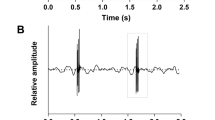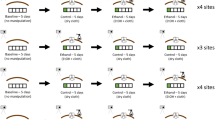Abstract
During the dawn chorus, territorial male songbirds vocalise intensively within signalling range of several conspecific males and can therefore be considered members of a busy communication network. The more or less continuous singing over a long period of time under standardised stimulus conditions makes the dawn song a potentially important information source both for simple receivers and for eavesdroppers. Male blue tits (Parus caeruleus) vary in features of their dawn song, e.g. older males sing longer strophes, and females choose males that sing longer strophes as extra-pair partners. However, so far, dawn song in the blue tit has been investigated separately from other singing behaviour of the same males. In this study, we investigate aspects of blue tit male quality, reflected in dawn song characteristics, and their predictive value for how males behave during singing interactions later in the morning. We acted as simple receivers by recording the singing activity of one male at a time at dawn and compared features of its dawn song, such as onset before sunrise, repertoire size, mean bout length, strophe length and percentage performance time to responses of the same male to a territory intrusion simulated by playback of synthesised songs later during the same morning. We assume that an aggressive response towards an intruder will involve a fast approach to the loudspeaker broadcasting strophes of blue tit song, searching for the intruder (flying around), and a high amount of counter singing and overlapping of the intruder’s songs. Aspects of vigour of response to the simulated intrusion could be predicted from all five investigated dawn song parameters as well as male age. This is, to our knowledge, the first indication that a simple receiver could extract reliable information from a male’s dawn singing behaviour about its competitiveness later in the day.

Similar content being viewed by others
References
Adhikerana AS, Slater PJB (1993) Singing interactions in coal tits, Parus ater: An experimental approach. Anim Behav 46:1205–1211
Balsby TJ (2000) Song activity and variability in relation to male quality and female choice in whitethroats Sylvia communis. J Avian Biol 31:56–62
Bijnens L (1988) Blue Tit Parus Caeruleus Song in relation to survival reproduction and biometry. Bird Study 35:61–68
Bijnens L, Dhondt AA (1984) Vocalizations in a Belgian blue tit, Parus c. caeruleus, population. Gerfaut 74:243–269
Blumenrath S, Dabelsteen T, Pedersen SB (accepted) Do locations inside nest boxes complicate the receiving conditions for great tit females? Bioacoustics
Burt JM, Trillo PA, Vehrencamp SL (2001) Two-way and mulit-way vocal interactions in a territoral songbird. XXVII International Ethological Conference, Tübingen, Germany
Catchpole CK, Slater PJB (1995) Bird song: biological themes and variations. Cambridge University Press, Cambridge
Dabelsteen T, McGregor PK (1996) Dynamic acoustic communication and interactive playback. In: Kroodsma DE, Miller EH (eds) Ecology and evolution of acoustic communication in birds Cornell University Press, Ithaca, N.Y., pp 398–408
Dabelsteen T, Pedersen SB (1990) Song and information about aggressive responses of blackbirds, Turdus merula: evidence from interactive playback experiments with territory owners. Anim Behav 40:1158–1168
Dabelsteen T, Pedersen SB (1992) Song features essential for species discrimination and behaviour assessment by male blackbirds. Behaviour 121:259–287
Dabelsteen T, McGregor PK, Shepherd M, Whittaker X, Pedersen SB (1996) Is the signal value of overlapping different from that of alternating during matched singing in great tits? J Avian Biol 27:189–194
Dabelsteen T, McGregor PK, Holland J, Tobias JA, Pedersen SB (1997) The signal function of overlapping singing in male robins. Anim Behav 53:249–256
Doutrelant C, Blondel J, Perret P, Lambrechts MM (2000) Blue tit song repertoire size, male quality and interspecific competition. J Avian Biol 31:360–366
Foerster K (2002) Extra-pair paternity in the blue tit Parus caeruleus Doctoral thesis, Zoological Institute, Univ. Vienna
Godfrey JD, Bryant DM (2000) State-dependent behaviour and energy expenditure: an experimental study of European robins on winter territories. J Anim Ecol 69:301–313
Hill CE, Campbell SE, Beecher MD (subm) Does femal choice select for male song repertoires? Female choice of extra-pair mates and male song characteristics in the song sparrow. Behavioural Ecology
Johnsen A, Lifjeld JT, Rohde PA (1997) Coloured leg bands affect male mate-guarding behaviour in the bluethroat. Anim Behav 54:121–130
Kempenaers B, Verheyen GR, Van Der Broeck M, Burke T, Van Broeckhoven C, Dhondt AA (1992) Extra-pair paternity results from female preference for high-quality males in the blue tit. Nature 357:494–496
Kempenaers B, Verheyen GR, Dhondt AA (1997) Extrapair paternity in the blue tit (Parus caeruleus): female choice, male characteristics, and offspring quality. Behav Ecol 8:481–492
Lambrechts M, Dhondt AA (1986) Male quality reproduction and survival in the great tit Parus major. Behav Ecol Sociobiol 19:57–64
Langemann U, Tavares IP, Peake TM, McGregor PK (2000) Response of great tits to escalating patterns of playback. Behaviour 137:451–471
Larsen ON, Dabelsteen T (1997) The VIFA 1” Neodymium tweeter: a versatile speaker for playback experiments. Bioacoustics 8:323–326
Mace R (1986) Importance of female behaviour in the dawn chorus. Anim Behav 34:621–622
McGregor P, Dabelsteen T (1996) Communication networks. In: Kroodsma DE, Miller EH (eds) Ecology and evolution of acoustic communication in birds Cornell University Press, Ithaca, N.Y., pp 409-425
McGregor PK, Dablesteen T, Shepherd M, Pedersen SB (1992) The signal value of matched singing in great tits: evidence from interactive playback experiments. Anim Behav 43:987–998
Mennill DJ, Ratcliffe L (2004) Overlapping and matching in the song contests of black-capped chickadees. Anim Behav (in press)
Mennill DJ, Ratcliffe L, Boag P (2002) Female eavesdropping on male song contests in songbirds. Science 296:872–873
Naguib M, Todt D (1997) Effects of dyadic vocal interaction on additional conspecific receivers in nightingales. Anim Behav 54:1535–1543
Nowicki S, Searcy WA, Krueger T, Hughes M (2002) Individual variation in response to simulated territorial challenge among territory-holding song sparrows. J Avian Biol 33:253–259
Otter K, Chruszcz B, Ratcliffe L (1997) Honest advertisement and song output during the dawn chorus of black-capped chickadees. Behav Ecol 8:167–173
Otter K, McGregor PK, Terry AMR, Burford FRL, Peake TM, Dabelsteen T (1999) Do female great tits (Parus major) assess males by eavesdropping? A field study using interactive song playback. Proc R Soc Lond B 266:1305–1309
Peake TM, Terry AMR, McGregor PK, Dabelsteen T (2001) Male great tits eavesdrop on simulated male-male vocal interactions. Proc R Soc Biol Sci B 268:1183–1187
Peake TM, Terry AMR, McGregor PK, Dabelsteen T (2002) Do great tits assess rivals by combining direct experience with information gathered by eavesdropping? Proc R Soc Lond B 269, 1925–1929
Poesel A, Dabelsteen T (2001) Variation in blue tit down song - A consequence of male quality and female eavesdropping? Advances in Ethology 36:240
Poesel A, Foerster K, Kempenaers B (2001) The dawn song of the blue tit Parus caeruleusand its role in sexual selection. Ethology 107:521–531
Rice WR (1989) Analyzing tables of statistical tests. Evolution 43:223–225
Searcy WA. (1983) Response to multiple song types in male song sparrows and field sparrows. Anim Behav 31:948–949
Searcy WA, Yasukawa K (1996) Song and female choice. In: Kroodsma DE, Miller EH (eds) Ecology and evolution of acoustic communication in birds. Cornell University Press, Ithaca, N.Y., pp 454–473
Silverin B (1998) Territorial behaviour and hormones of the pied flycatcher in optimal and suboptimal habitats. Anim Behav 56:811–818
Slagsvold T, Dale S, Sætre G-P (1994) Dawn singing in the great tit (Parus major): mate attraction, mate guarding, or territorial defence?Behaviour 131:115–138
Sokal RR, Rohlf FJ (1995) Biometry. The principles and practice of statistics in biological research. Freeman, New York
Staicer CA (1996) Honest advertisement of pairing status—evidence from a tropical resident wood-warbler. Anim Behav 51:375–390
Stoddard PK, Beecher Michael D, Willis M (1988) Response of territorial male song sparrows to song types and variations. Behav Ecol Sociobiol 22:125–130
Svensson E (1992) Identification guide to European passerines. Fingraf, Sweden
Welling P, Koivula K, Lahti K (1995) The dawn chorus is linked with female fertility in the willow tit Parus montanus. J Avian Biol 26:241–246
Acknowledgements
We thank Hans Winkler from the Konrad Lorenz Institute for Comparative Ethology, Vienna for continuous support during this study. We are grateful to Bart Kempenaers from the Research Centre for Ornithology for logistic support and Agnes Tuerk for invaluable help in the field. Raphael-Thomas Klumpp and Alfred Fojt from the institute of Silviculture, Vienna, provided access to their facilities in the study area. We thank Christian Schlögel for excellent help with song recordings and Ronald Smetacek for technical assistance. We are grateful to Thorsten Balsby for fruitful discussions, statistical advice and comments on the manuscript and to two anonymous referees whose comments improved the manuscript. The Danish National Research Foundation and the Centre for Sound Communication supported this study. The research was conducted in accordance with the laws in Austria and Denmark.
Author information
Authors and Affiliations
Corresponding author
Additional information
Communicated by P.K. McGregor
Rights and permissions
About this article
Cite this article
Poesel, A., Dabelsteen, T. & Pedersen, S.B. Dawn song of male blue tits as a predictor of competitiveness in midmorning singing interactions. acta ethol 6, 65–71 (2004). https://doi.org/10.1007/s10211-004-0086-0
Received:
Revised:
Accepted:
Published:
Issue Date:
DOI: https://doi.org/10.1007/s10211-004-0086-0




